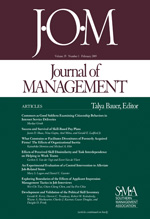Is Social Sharing Beneficial For Employees When Dealing With Difficult Situations at Work?
A. Silke McCance, Christopher D. Nye, Lu Wang, Kisha S. Jones, and Chi-yue Chiu discuss this question in their recent article, “Alleviating the Burden of Emotional Labor: The Role of Social Sharing”, recently published in OnlineFirst for Journal of Management:
Who is the target audience for this article?
This article may be of interest to a diverse audience, as it covers a topic of relevance to Industrial/Organizational Psychologists, Business and Management scholars, and Social Psychologists alike. Scholars interested in the broad topics of emotions at the workplace and customer service should find our results interesting. The article also has strong practical implications, thus making it relevant to service organizations and managers of service employees in many different industries.
What Inspired You To Be Interested In This Topic?
My co-authors and I were inspired to conduct a study aimed at helping service employees cope with difficult job demands. Scholars interested in emotional labor have examined the antecedents, correlates, and outcomes of the construct, and the overwhelming conclusion of the body of literature surrounding emotional labor is that it is bad for the employees who have to engage in it. However, there is a severe dearth of research on interventions that could help improve the daily work life of service employees. Difficult customer interactions are ubiquitous, and given the service mantra that “the customer is always right,” emotional labor will continue to be around.
Were There Findings That Were Surprising To You?
We expected social sharing to generally have beneficial effects, and based on the literature posited positive sharing – that is, employees who were encouraged to look at taxing service experiences in a positive light, thinking of their accomplishments in handling a difficult situation – to be most effective in helping service employees cope with the aftereffects of such difficult customer service episodes. To our surprise, the different forms of social sharing (positive sharing, sharing of facts, and sharing of feelings) worked equally well. To our delight, the qualitative data revealed that the different types of sharing worked for different reasons. This study has been an interesting process of exploration and discoveries, which has led to a more nuanced understanding of how social sharing could potentially ease the burden of emotional labor jobs.
How Do You See This Study Influencing Future Research And/Or Practice?
This study only scrapes the tip of the iceberg when it comes to investigating interventions to alleviate the burden of emotional labor jobs. We hope our results encourage service organizations to instigate social sharing “behind the scenes,” and that future research can examine (longitudinally, if possible) the effectiveness of this intervention in the workplace with actual employees. Such longitudinal data using multiple methods is needed to address questions about the divergent effects of the sharing types on employees’ long-term emotional well-being. In general, it is our hope that more scholars will look at ways to help service employees deal with the difficulties of their job, versus merely documenting these difficulties.
How Does This Study Fit Into Your Body Of Work/Line Of Research?
This study is a natural extension of my line of research on emotional labor, which has focused in particular on customer injustice, discrete emotions, and individual differences. After establishing that difficult customers pose a problem for service employees, I wanted to examine possible ways of alleviating this situation. I have also recently begun looking at emotional labor training as another intervention to help service employees deal with difficult job demands, and studying emotional labor in intercultural service encounters to investigate the construct in a broader context.
How Did Your Paper Change During The Review Process?
We did not anticipate that the qualitative data could be so useful in uncovering the nuanced mechanisms at work in the different types of social sharing. The editor and reviewers encouraged us to integrate the experimental results with an analysis of the transcripts of the service interactions. We believe this integration greatly contributed to the depth of our results.
What, If Anything, Would You Do Differently If You Could Go Back And Do This Study Again?
We believe our study, despite its obvious limitations, presents convincing results that can inform an important issue faced by service providers on the job. Nonetheless, as mentioned above, our study merely scrapes the tip of the iceberg. Based on hindsight, we would have liked to more closely examine different aspects of the sharing dynamic by having even more experimental groups; e.g., a group in which only one person had difficult service encounters, while everyone else’s were pleasant, or a group that left out the “social” aspect of sharing by removing any feedback from others.
![]()




















































































